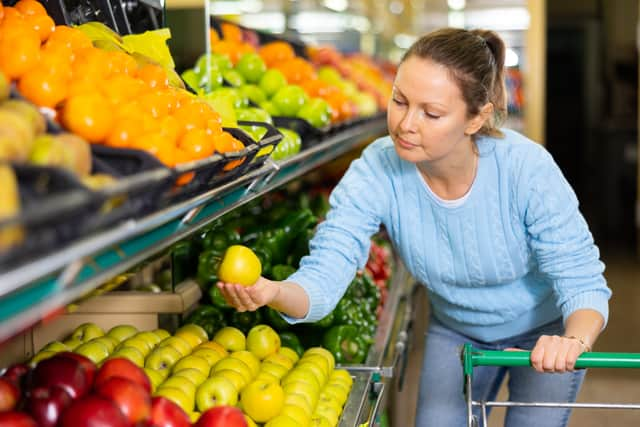UK food inflation rate falls: supermarket price rises findings explained - are grocery costs going down?
and live on Freeview channel 276
UK food price inflation fell marginally in April, leading to hopes the worst of supermarket price rises may have passed.
According to data analytics firm Kantar, the rate of food inflation dipped to 17.3% from 17.5% the previous month. While it means price hikes have softened slightly, they are still rocketing at a rapid rate.
It comes after NationalWorld analysis of value range products across the country’s biggest retailers showed stores were putting prices up at a rate well above headline inflation. It also follows the latest official ONS inflation announcement, which showed the headline rate of the Consumer Prices Index (CPI) fell by less than expected in March 2023.
Core inflation, which excludes food and energy bills, is remaining stubbornly high. It is now expected the Bank of England will hike its base rate again in May in a bid to push inflation down.
So, what do Kantar’s latest findings tell us about food inflation - and what has separate research by Nationwide Building Society revealed about the cost of living crisis more broadly?
Are food prices going down?
Food price rises have been one of the main features of the cost of living crisis. The Russia-Ukraine war and weather-related shortages have both been key drivers of this inflation.
But analysis by grocery data insights firm Kantar has shown the rate of price hikes dipped 0.2 percentage points to 17.3% compared to last year over the four weeks to 16 April 2023. It comes after 10 months of double-digit growth.


Kantar also found that supermarket own-label sales had grown 13.5% against the year, while their cheapest value lines had seen sales soar 46%. Items from such ranges are now appearing in a fifth of all shopping baskets as people seek out cheaper options, the analysts said.
Fraser McKevitt, head of retail and consumer insight at Kantar, said: “The latest drop in grocery price inflation will be welcome news for shoppers but it’s too early to call the top. We’ve been here before when the rate fell at the end of 2022, only for it to rise again over the first quarter of this year. It’s important to remember, of course, that falling grocery inflation doesn’t mean lower prices, it just means prices aren’t increasing as quickly.”
The latest Kantar data comes just days after the ONS’s own measure of food price inflation showed prices rose by an average of 19.1% in the year to March 2023. Olive oil (49.2%), whole milk (37.9%) and pork (25.2%) saw some of the biggest increases. With shortages hitting supermarkets once again, food prices could still continue to rise over the coming weeks.
“Prices are still shooting up at a ridiculously uncomfortable level that’s making every shopping trip something to be endured,” said head of financial analysis at AJ Bell, Danni Hewson.
“Consumers are trying every trick in the book to keep their final bill at manageable levels, but with the Spanish weather once again playing havoc with some salad supplies, people will take this downward trend with a large, and now more expensive, pinch of salt.
“People are finding ways to budget for the things that make life worth living, like plentiful supplies of chocolate eggs, but that’s coming at the cost of other expenditure. Inflation-weary has become a well-used phrase but it’s what we are all feeling and even if inflation has finally peered over the peak, the reality is higher prices aren’t going anywhere any time soon.”
What has Nationwide research found?
Kantar’s data release came out as Nationwide Building Society published its own cost of living findings. The financial giant analysed 234 million transactions made by its customers during the month of March.
It found spending on essentials was 11% higher year-on-year, with the gap between essential and non-essential spend now sitting at 43% (£1.33 billion) as people have attempted to cut back on their outgoings. Utility bills (+28%), supermarket shopping (+16%) and mortgage repayments (+16%) have been leading the growth in essential spending over the past year. The non-essential categories that have seen the biggest spending increases according to Nationwide’s data have been airline travel (+37%), digital goods (+23%) and holidays (+16%).


Several non-essential categories have seen a big drop-off in the amount of transactions taking place, including dating (-33%), gardening (-7%) and subscriptions (-6%). It comes after an April Censuswide poll of more than 2,000 UK adults commissioned by Nationwide found the number of people concerned about the state of their finances and ability to afford essentials had grown to 67% - up from 63% last month. This figure was below the 70% the poll recorded in February 2023.
Mark Nalder, payments strategy and performance director at Nationwide, said: “With inflation remaining high and the rising cost of living, it’s perhaps unsurprising to see an increase in the number of people concerned about their finances and ability to cover the essential costs. As our data shows, high essential costs are impacting how the nation spends its spare money.
“Despite pressures, discretionary spend remains fairly buoyant as households continue to balance what they need versus what they want. We should expect to see this continue as we approach summer and the weather gets warmer.”
Comment Guidelines
National World encourages reader discussion on our stories. User feedback, insights and back-and-forth exchanges add a rich layer of context to reporting. Please review our Community Guidelines before commenting.
